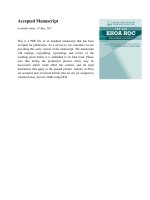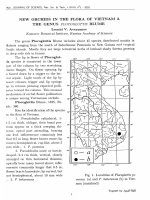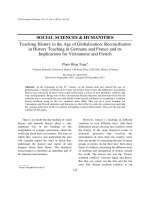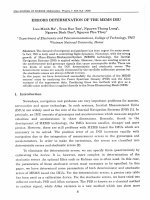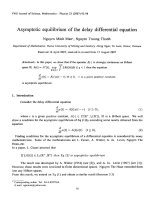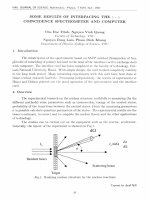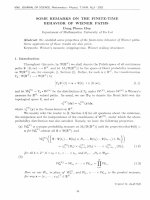DSpace at VNU: Chemical composition of the flower essential oil of Artabotrys hexapetalus (L. f.) bhandare of Vietnam
Bạn đang xem bản rút gọn của tài liệu. Xem và tải ngay bản đầy đủ của tài liệu tại đây (67.9 KB, 3 trang )
This article was downloaded by: [University of Connecticut]
On: 08 October 2014, At: 09:20
Publisher: Taylor & Francis
Informa Ltd Registered in England and Wales Registered Number: 1072954 Registered office: Mortimer
House, 37-41 Mortimer Street, London W1T 3JH, UK
Journal of Essential Oil Research
Publication details, including instructions for authors and subscription information:
/>
Chemical Composition of the Flower Essential Oil of
Artabotrys hexapetalus (L. f.) Bhandare of Vietnam
a
a
Giang M. Phan , Son T. Phan & Wilfried A. König
b
a
Faculty of Chemistry , College of Natural Science, Vietnam National University , 19 Le
Thanh Tong Street, Hanoi
b
Institut für Organische Chemie, Universität Hamburg , D-20146, Hamburg, Germany
Published online: 28 Nov 2011.
To cite this article: Giang M. Phan , Son T. Phan & Wilfried A. König (2007) Chemical Composition of the Flower Essential
Oil of Artabotrys hexapetalus (L. f.) Bhandare of Vietnam, Journal of Essential Oil Research, 19:6, 523-524, DOI:
10.1080/10412905.2007.9699321
To link to this article: />
PLEASE SCROLL DOWN FOR ARTICLE
Taylor & Francis makes every effort to ensure the accuracy of all the information (the “Content”) contained
in the publications on our platform. However, Taylor & Francis, our agents, and our licensors make no
representations or warranties whatsoever as to the accuracy, completeness, or suitability for any purpose of
the Content. Any opinions and views expressed in this publication are the opinions and views of the authors,
and are not the views of or endorsed by Taylor & Francis. The accuracy of the Content should not be relied
upon and should be independently verified with primary sources of information. Taylor and Francis shall
not be liable for any losses, actions, claims, proceedings, demands, costs, expenses, damages, and other
liabilities whatsoever or howsoever caused arising directly or indirectly in connection with, in relation to or
arising out of the use of the Content.
This article may be used for research, teaching, and private study purposes. Any substantial or systematic
reproduction, redistribution, reselling, loan, sub-licensing, systematic supply, or distribution in any
form to anyone is expressly forbidden. Terms & Conditions of access and use can be found at http://
www.tandfonline.com/page/terms-and-conditions
hexapetalus
J. Essent. Oil Res., 19,A.523–524
(November/December 2007)
Chemical Composition of the Flower Essential Oil of
Artabotrys hexapetalus (L. f.) Bhandare of Vietnam
Giang M. Phan and Son T. Phan,*
Faculty of Chemistry, College of Natural Science, Vietnam National University, 19 Le Thanh Tong Street, Hanoi
Wilfried A. König# ,
Institut für Organische Chemie, Universität Hamburg, D-20146 Hamburg, Germany
Downloaded by [University of Connecticut] at 09:20 08 October 2014
Abstract
The pleasant smelling flower essential oil of Artabotrys hexapetalus (L. f.) Bhandare (Annonaceae) was analyzed
by GC and GC/MS. Twenty-six components of the oil including sesquiterpene hydrocarbons (33.3% of the oil) and
oxygenated sesquiterpenoids (47.7%) were identified. β-caryophyllene (11.4%) and caryophyllene oxide (31.5%) were
identified as the major components of the oil.
Key Word Index
Artabotrys hexapetalus, Annonaceae, essential oil composition, β−caryophyllene, caryophyllene oxide.
Plant Name
Present work
Artabotrys hexapetalus (L. f.) Bhandare, Annonaceae
(Vietnamese name Cay Mong Rong).
Gas Chromatography: An Orion Micromat 412 instrument
equipped with two fused silica capillary columns (25 m × 0.25
mm, film thickness 0.15 µm) coated with non-polar CPSil-5-CB
and more polar CPSil-19-CB (Chrompack), respectively, split
injection and flame ionization detection, was used. Injection
and detector temperatures were maintained at 200°C and
250°C, temperature program 50°–230°C at 3°C/min, carrier
gas H2 at 1.2 mL/min.
Gas Chromatography–Mass Spectrometry: A HewlettPackard HP 5890 gas chromatograph, coupled to a VG Analytical
70-250S mass spectrometer. The GC was fitted with a fused
silica capillary column coated with CPSil-5-CB (25 m × 0.25
mm, film thickness 0.15 µm). The GC operating conditions
were identical to those described above. The MS operating
parameters were: ionization voltage, 70 eV; ion source temperature, 230°C; He was used as the carrier gas.
The oil was analyzed using GC on a non-polar fused CPSil-5CB and a more polar CPSil-19-CB capillary columns of identical
dimensions, and GC/MS on a CPSil-5-CB column. Retention
indices and mass spectra of the constituents were compared
with those of authentic samples and a computer-supported
spectral library under identical experimental conditions
(1,2). Twenty-six components representing 81% of the oil
were identified (Table I). The representative constituents of
sesquiterpene hydrocarbons (33.3% of the oil) and oxygenated
Source
The fresh flowers of A. hexapetalus were collected in Hoang
Mai Village, Hanoi, Vietnam. The plant material was identified by Dr. Nguyen Hoanh Coi, Military Institute of Drugs
Control, Hanoi, Vietnam, and voucher specimens are kept
in the Herbarium of the Laboratory of Chemistry of Natural
Products, Faculty of Chemistry, College of Natural Science,
Vietnam National University, Hanoi, Vietnam.
Plant Part
The fresh flowers were subjected to hydrodistillation for 8
h to produce an oil of 0.94% yield based on the fresh weight.
The oil was dried over anhydrous sodium sulphate.
Previous work
To the best of our knowledge, no chemical information on
the essential oil from A. hexapetalus has been reported.
*Address for correspondence
# deceased
Received: October 2005
Revised: January 2006
1041-2905/07/0005-0523$14.00/0—© 2007 Allured Publishing Corp.
Vol. 19, November/December 2007
Accepted: February 2006
Journal of Essential Oil Research/523
Phan et al.
Table I. Percentage composition of the flower oil of
Artabotrys hexapetalus
Downloaded by [University of Connecticut] at 09:20 08 October 2014
Compound
sesquiterpenoids (47.7%) were β−caryophyllene (11.4%) and
caryophyllene oxide (31.5%), respectively.
Percentage composition (%)a)
α-cubebene
α-ylangene
α-copaene
β-elemene
Sativene
ylanga-2,4(15)-diene
isocaryophyllene
β-caryophyllene
β-copaene
α-humulene
allo-aromadendrene
γ-muurolene
bicyclosesquiphellandrene
α-muurolene
(E,E)-α-farnesene
γ-cadinene
calamenene
δ-cadinene
α-calacorene
caryophyllene oxide
globulol
humulene epoxide*
1-epi-cubenol
1(10)-spirovetiven-7β-ol
selin-11-en-4-ol
saccogynol
0.2
0.6
8.1
1.0
0.1
0.1
0.3
11.4
0.1
3.5
0.1
3.5
0.4
1.0
t
0.5
0.7
1.1
0.6
31.5
0.5
10.0
2.0
2.5
0.2
1.0
Acknowledgments
This work was financially supported by Volkswagen Stiftung (Partnerschaftsvorhaben “Untersuchung ätherischer Öle Vietnams”).
References
1. D. Joulain and W.A. König, The Atlas of Spectral Data of Sesquiterpene
Hydrocarbons. E.B.-Verlag, Hamburg (1998).
2. D.H. Hochmuth, W.A. König and D. Joulain, MassFinder 2.3. Software and
Data Bank, Hamburg (2003). Available at: www.massfinder.com.
t = trace (<0.05%)
a)
Relative percentages were obtained on the GC CPSil-5-CB column.
* correct isomer not identified
524/Journal of Essential Oil Research
Vol. 19, November/December 2007

